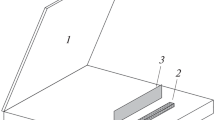Abstract
Many theories of exploiting spatial diversity in wireless communications and more recently space-time coding are results of understanding the spatial channel models for antenna array communication systems. For example, the models for rich scattering environments assume the channel coefficients to be almost independent when the spacing between the antennas is sufficient. This could limit the possibility of extracting direction of the signal propagation with respect to antenna locations (G. Xu et al., IEEE Transactions on Signal Processing, Vol. 42, No. 2, pp. 349–355, 1994). On the other hand, when the scattering is limited to few dominant reflectors, the directions of the signals traveling through the environment can prevail in the channel coefficients. Extracting the propagation direction (beam direction) information from the channel coefficients has been investigated extensively in array signal processing literature. These investigations have led to many algorithms of direction of arrival (DOA) estimation and beamforming. Here, we propose a transmit diversity technique that exploits beam directions in environments with few beam directions. While we present this technique for two-beam Rayleigh fading channels (J.E. Mazo, IEEE Transaction on Communication, Vol. 39, No. 7, pp. 1027–1030, 1991), it can be easily extended to multibeam general fading channels. The proposed method does not require feedback from the receiver.
Similar content being viewed by others
References
V. Tarokh, H. Jafarkhani and A.R. Calderbank, “Space-time Block Codes From Orthogonal Designs”, IEEE Transactions Information Theory, Vol. 45, pp. 1456–1467, 1999.
V. Tarokh, N. Seshadri and A.R. Calderbank, “Space-Time Codes for High Data Rate Wireless Communications: Performance Analysis and Code Construction”, IEEE Transactions Information Theory, Vol. 44, pp. 744–765, 1998.
S.M. Alamouti, “A Simple Transmit Diversity Technique for Wireless Communications”, IEEE Journal on Selected Areas in Communications, Vol. 16, No. 8, pp. 1451–1458, 1998.
G.J. Foschini and M.J. Gans, “On Limits of Wireless Communication in a Fading Environment When Using Multiple Antennas”, Wireless Personal Communications, Vol. 6, No. 3, pp. 311–335, 1998.
A. Kavak, M. Torlak, W.J. Vogel and G. Xu, “Vector Channels for Smart Antennas: Measurements, Statistical Modeling, and Directional Properties in Outdoor Environments”, IEEE Transactions on Microwave Theory and Techniques, Vol. 48, No. 6, pp. 930–937, 2000.
G. Xu, S.D. Silverstein, R.H. Roy and T. Kailath, “Beamspace ESPRIT”, IEEE Transactions on Signal Processing, Vol. 42, No. 2, pp. 349–355, 1994.
M.D. Zoltowski, G.M. Kautz and S.D. Silverstein, “Beamspace Root MUSIC”, IEEE Transactions on Signal Processing, Vol. 41, No. 1, pp. 344–364, 1993.
M. Katz and J. Ylitalo, “Extension of Space-Time Coding to Beamforming WCDMA Base Stations”, in Proceeding of IEEE Vehicular Technology Conference, Tokyo, Japan, pp. 1230–1234, 2000.
J.A.J. Lempiäinen, and K.I. Nikoskinen, “Signal Correlations and Diversity Gain of Two-Beam Microcell Antenna”, IEEE Transactions on Vechicular Tech., Vol. 47, No. 3, pp. 755–765, 1998.
G. Raleigh, S.N. Diggavi, A.F. Naguib and A. Paulraj, “Characterization of Fast Fading Vector Channels for Multi-Antenna Communication Systems”, in Proceeding of IEEE Asilomar Conference on Signals, Systems and Computers Pacific Grove, CA, pp. 853–857, 1994.
J.H. Winters, “Smart Antennas for Wireless Systems”, IEEE Personal Communications Magazine, Vol. 5, No.1, pp. 23–27, 1998.
J.G. Proakis, Digital Communications. (4th edn) McGraw-Hill, New York, 2001.
R.B. Ertel, P. Cardieri, K.W. Sowery, T.S. Rappaport and J.H. Reed, “Overview of Spatial Channel Models for Antenna Array Communication Systems”, IEEE Personal Communications, pp. 10–22, 1998.
J.E. Mazo, “Exact Matched Filter Bound for Two-Beam Rayleigh Fading”, IEEE Transactions on Communications, Vol. 39, No. 7, pp. 1027–1030, 1991.
Author information
Authors and Affiliations
Rights and permissions
About this article
Cite this article
Torlak, M. Performance of Beamspace Transmit Diversity Technique in Two Beam Rayleigh Fading Channels. Wireless Personal Communications 28, 277–286 (2004). https://doi.org/10.1023/B:WIRE.0000033600.02077.8c
Issue Date:
DOI: https://doi.org/10.1023/B:WIRE.0000033600.02077.8c



